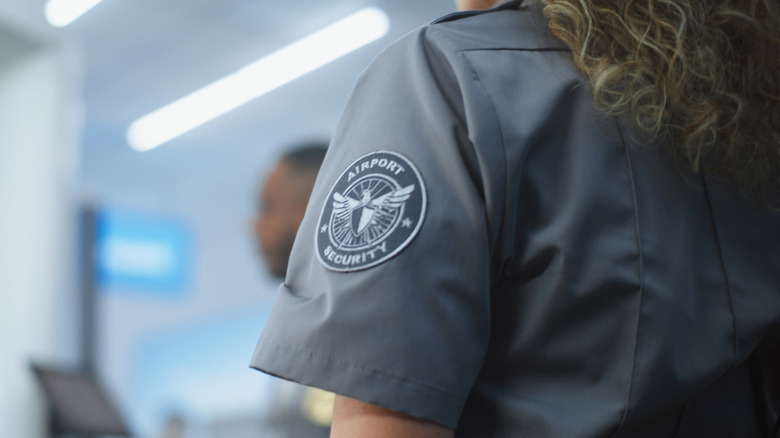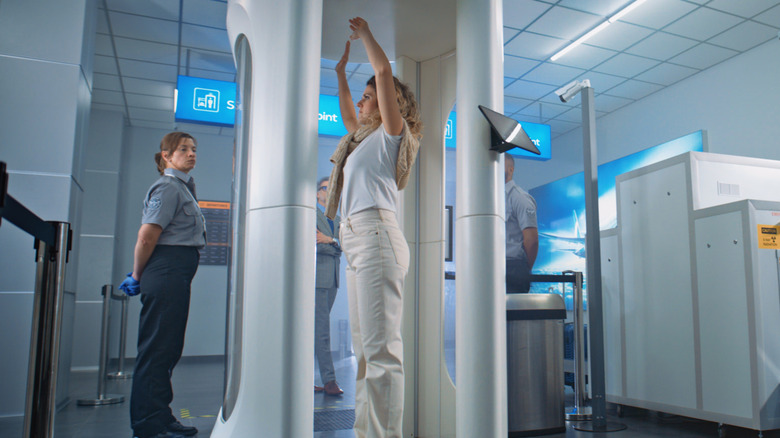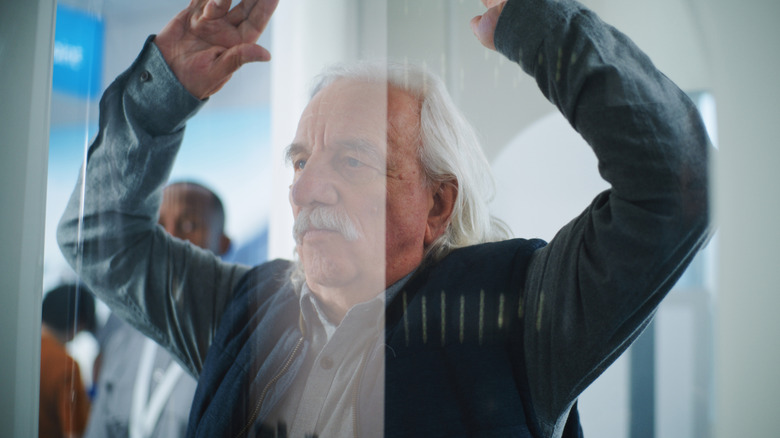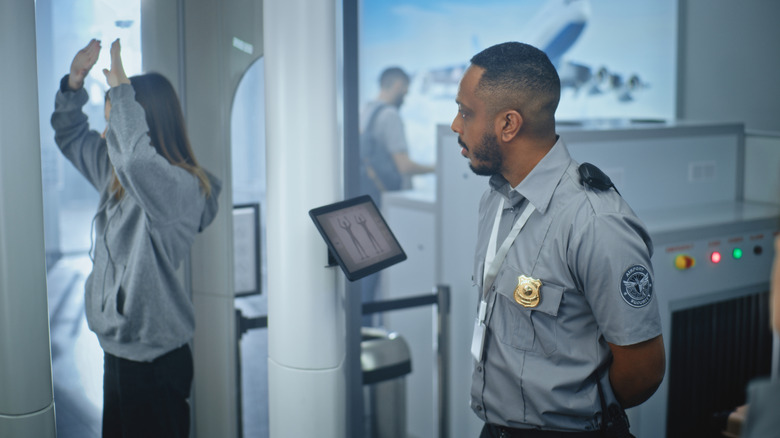Why TSA Changed The Body Scanners They Use And What They Now See
There's nothing as simultaneously reassuring and infuriating as modern airport security. Anyone who's done even a little traveling knows the feeling of arriving at the airport only to be greeted by a long security line of harried travelers frantically shedding clothing and dutifully laying laptops in trays before traipsing through rows of body scanners. Yet, were we all allowed to saunter through the airport foyer without anyone bothering to give our bags even a cursory rummage, we'd all feel more than a little unsettled.
Believe it or not, there was a time when airport security was a comparatively breezy experience. Prior to 9/11, anyone could pass checkpoints and enter the concourse regardless of whether they were flying, and while scans were carried out on carry-on bags, there was no requirement to remove shoes or belts or place laptops and liquids in trays. Metal detectors were also in place, but otherwise, pre-9/11 airport security was a much simpler affair.
Following the awful events of September 11, 2001, however, the Transportation Security Administration (TSA) was created and security measures were enhanced across the board. By 2010, advanced "full-body scanners" were being installed at airports across the country, partially a response to a 2009 incident in which a passenger tried smuggling plastic explosives in his underwear. Ever since, travelers have gotten used to standing inside these units, holding their hands above their heads while the technology does a sweep to detect items that could evade traditional metal detectors. But this technology has proved controversial ever since its introduction due to the detailed images of the human body it can create, which unsurprisingly prompted widespread concerns about passenger privacy. Ever since, the TSA has gradually changed the type of scanners and software used at airport security checkpoints. But what exactly do the new scanners do?
Full body scanning suddenly became ubiquitous at airports nationwide
By the end of 2010, roughly 500 full body scanners had been installed at airports in the U.S. and travelers weren't happy with what they saw as an invasive new technology. A 2011 study published in Archives of Internal Medicine explained how there were actually two types of full body scanners in use at the time: millimeter wave scanners and backscatter X-ray scanners. While they differed in terms of the radiation levels they emitted, both created detailed images of passengers' bodies, and were designed to detect restricted metallic and non-metallic items hidden under clothing without the need for a pat-down. Millimeter wave scanners did so by sending out low energy waves and capturing the energy reflected back, and backscatter X-ray scanners used radiation to penetrate soft tissue, detecting the radiation reflected off of the traveler. Lamentably, this meant that TSA staff were could see extremely detailed and explicit images of travelers which revealed intimate parts of their bodies.
Despite the TSA implementing some measures to protect passengers' privacy, these invasive scanners were met with a significant backlash. As CBS reported in 2010, groups comprising both passengers and pilots accused the TSA of violating their rights by using the machines, referring to their use as a "virtual strip search" and even calling for a Thanksgiving boycott. The outlet claimed at the time that 15% of Americans didn't want to use the scanners. Then, the Electronic Privacy Invasion Center sued the Department of Homeland Security over what it claimed were unlawful and needlessly invasive scanners. Alongside concerns over health and safety related to the backscatter machines' use of radiation and the elements used to make X-rays, as well as worries about increased security checkpoint wait times, it made for an extremely tumultuous debate.
The TSA began removing backscatter scanners soon after their debut
Two years after their initial implementation, the TSA began removing backscatter X-ray scanners from airports. Privacy concerns aside, the units also emitted small doses of a type of radiation known as ionizing radiation, which at higher levels had been linked to cancer, and were met with such criticism that the TSA seemingly reversed course very quickly. The official reason provided was that this would speed up wait times, with TSA spokesperson David Castelveter stating at the time (via Propublica), "It's being done strategically. We are replacing some of the older equipment and taking them to smaller airports."
But there was surely more to it than moving the backscatter scanners to smaller airports. In the 15 years since these scanners were introduced, the TSA has clearly made a push to use millimeter wave tech over backscatter tech, and it's hard to believe this wasn't propelled by a combination of privacy and health concerns.
In 2011, Propublica reported that there were roughly 300 millimeter wave scanners in use in the U.S. as opposed to about 250 backscatter scanners. By 2016 major changes had been made. A TSA video from that year not only stated that millimeter wave tech was the main method used by the administration to scan travelers, but went to great lengths to demonstrate that the latest machines didn't generate invasive body scans. Instead, they either display a green "OK" screen for when no contraband is detected, or a generic outline of a human body showing the location of the detected object, thereby "eliminat[ing] passenger-specific images."
Today, a CDC page on radiation from airport security screening states plainly that, in the United States, body scanning units use millimeter wave technology, and that the tech is used to create a 3D image that "resembles a fuzzy photo negative" and does not add to a person's ionizing radiation dose.
The TSA has slowly moved to scanners with more privacy protections
The slow but significant shift from backscatter to millimeter wave technology with increased privacy protections was confirmed by former TSA checkpoint worker Eri Jenkins, who in 2024 spoke to Reader's Digest about how scanners provide a "nondescript avatar image of the human anatomy" which "reveal items that might be on skin or inside clothing." This was backed up by author and communication researcher Shawna Malvini Redden, Ph.D., who has been studying the TSA since 2010 and explained how staff only see "this outline with a green 'clear' or a red 'stop and check' signal."
Malvini Redden also provided clarification on how these machines have changed over time, revealing that early versions of full-body scanners did not come with privacy protections, essentially allowing TSA workers to see travelers naked. Some safeguards were in place, however, such as having the worker viewing the images stationed in a remote location (unable to see the traveler), using radios to update the officers at the checkpoints if they needed to conduct a more thorough search.
Thankfully, today's machines are much more protective of passenger privacy, a result of the TSA slowly moving to millimeter wave scanners with increased privacy fairly soon after the introduction of full body scanners in 2010.



